Little boats are...well...little. By my definition, they can be towed by four-cylinder cars and ride on trailers without brakes. They are usually less than 400 lbs and often are powered by only wind, muscle, or both. The smallest ones can be placed on roof racks and carried atop a car. They are the types of boats that don’t force you to get rid of one because you want to get another. Little boats can accumulate.My friend Peter Duff once observed that I had 100' of skiffs. Two hundred feet is more like it, I suspect. I had 16 boats at last count, and have been fortunate enough to never have to get rid of any. Because they are small, each has its own feel in the water, providing a different kind of boat experience. My boats range from a state-of-the-art high-tech sailing canoe to a pine tar-finished traditional Norwegian double-ender. In addition to forcing me to develop on-the-water skills, my fleet of small craft has made me develop skills in organizing, storing, and transporting boats. The following is some of what I’ve learned from years of living with little boats. Author Ben Fuller stands with a fraction of the fleet at last summer’s Small Reach Regatta. “With small boats comes stuff,” he says. Knowing how to organize and transport that stuff is the key to living with little boats.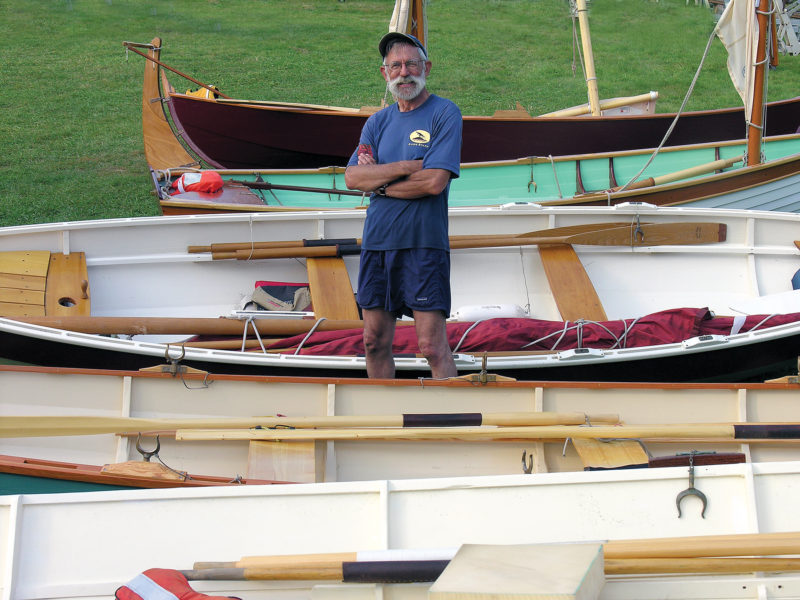 Photo by Matthew P. Murphy
Photo by Matthew P. Murphy
Join The Conversation
We welcome your comments about this article. To include a photo with your remarks, click Choose File below the Comment box.


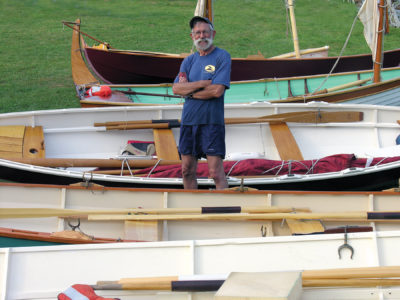
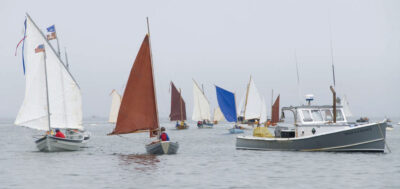
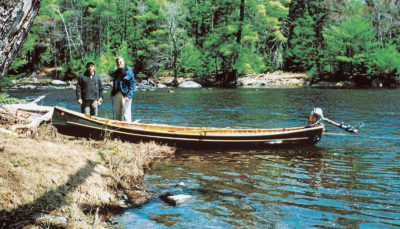
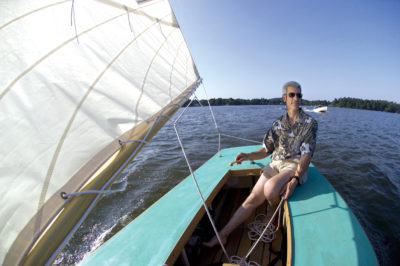
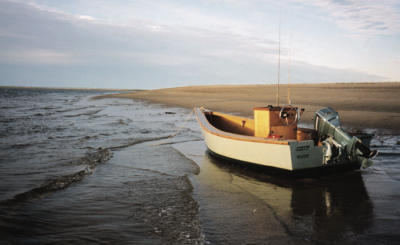
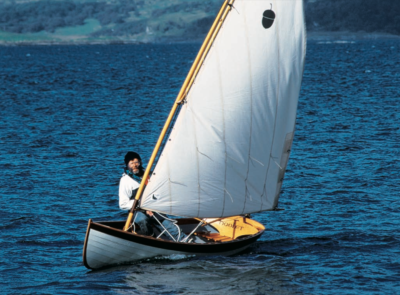
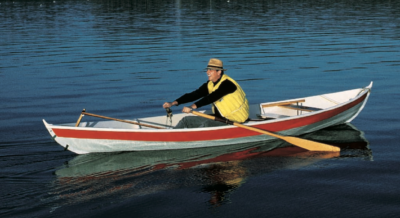
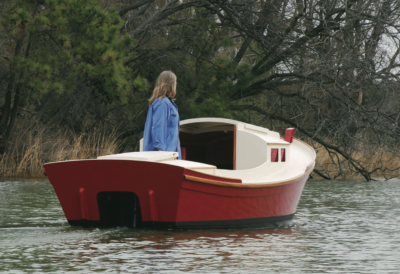
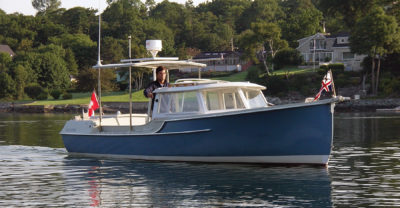
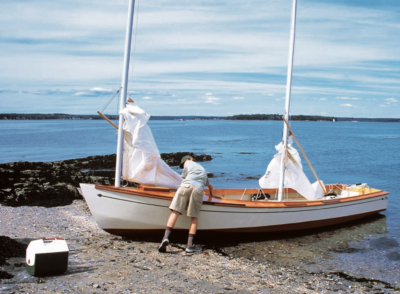


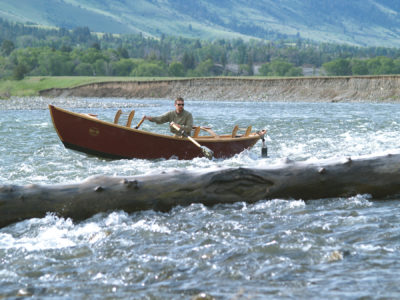
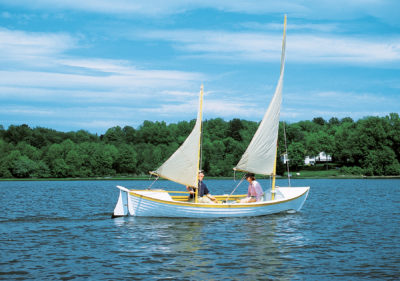

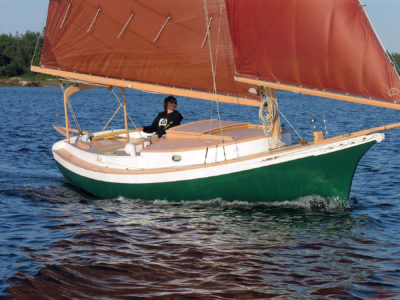
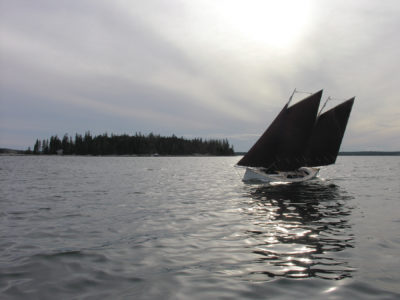
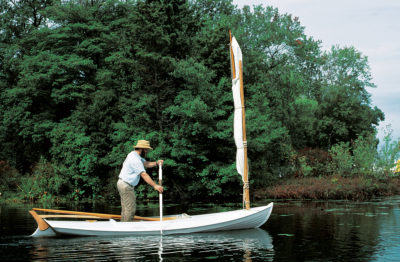
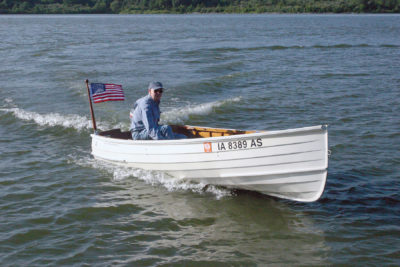
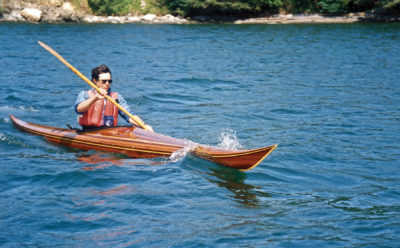
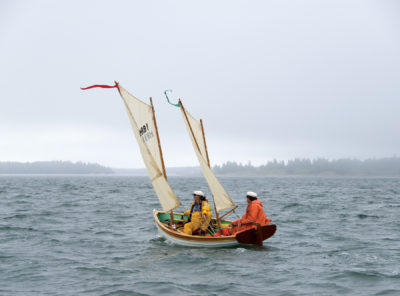
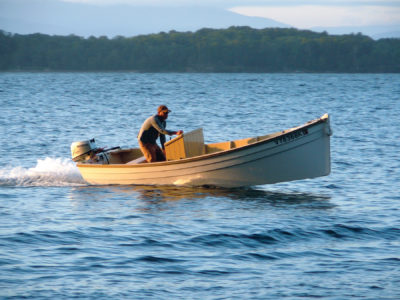
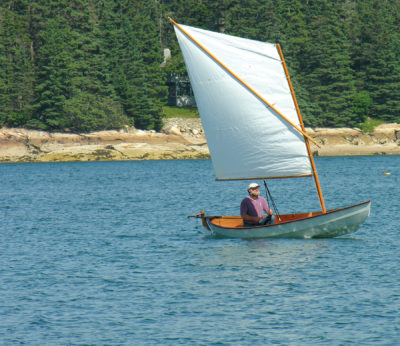
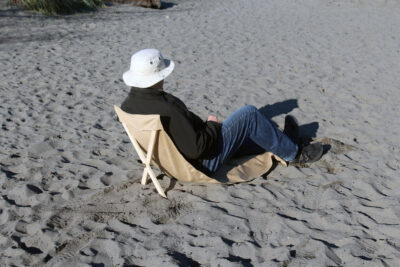
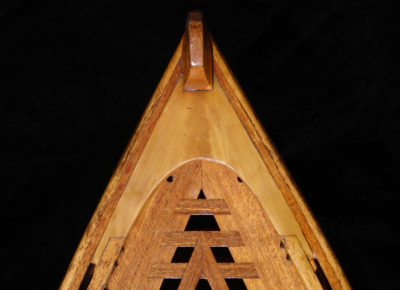
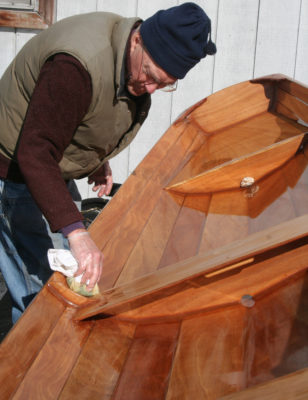
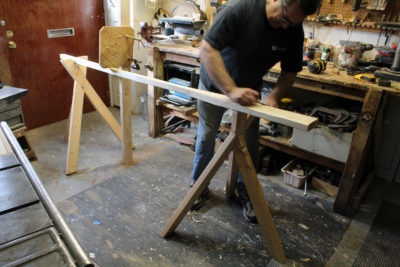
Something not mentioned (among many great ideas) for car-topping is suctioned rollers that attach to back of sedans or hatch backs (on the rear windows of the latter). They make the task of leaning the front of the boat onto something much easier (I can do it with an 8′ boat, from the ground, on a Prius), and then it’s just a matter of lifting the rear of the boat and rolling along until it reaches the back rack. They are meant for kayaks (and are shaped the fit the hull), and may not work too far outside that form factor, but I’ve put two on either side to get a box-shaped boat (parallel gunwales) onto the roof.
I don’t remember where I originally saw this idea, but I did refine it to solve a couple of inherent problems. I have this on my Toyota pickup with a canopy. The canopy top is level with the top of the cab, because I prefer to have my forward bar on the cab rather than on the canopy (because otherwise a long kayak may extend too far over the forward bar if that is located behind the cab roof, especially with an extra-cab design).
For the forward bar, I use a Yakima round bar, because I want to slide a pipe inside it, which would be problematic with a Thule rectangular bar. To use, I slide the pipe out of the round bar, far enough to hold the forward end of the kayak away from the cab—maybe a couple of feet or so. The bow slides onto the extension and rests there. I then lower the stern end of the kayak to the ground, followed by the forward end. Loading the boat is the reverse—forward end onto the pipe extension, then stern up, and then bow slid over onto the forward bar. At which point the pipe is slid back into the forward bar.
I saw one difficulty with this: how to hold the pipe in place in the forward bar. I didn’t take much imagination to picture the pipe shooting out when turning a corner, or jiggling out while traversing a rough road. My solution was to graft a threaded pipe end onto the bar tubing, and fixing a pipe cap to the extension pipe. (the pipe cap has to be large enough to screw onto this grafted pipe end). To lock the pipe in place, I slide the pipe into the tube, and twist the pipe cap onto the threaded end. This was a bit tricky to work out, but is really simple in practice (I have a photo of this, but will have to edit this later when I figure out how to import it).
My other point has to do with attire for launching. Raise your hand if you’ve never stepped in over your boot tops launching from or picking up on a trailer. Since Puget Sound is bitterly cold, even in summer, I have gotten in the habit of wearing a dry suit while paddling my kayak, even on a hot day. Gore Tex allows this, as the material breathes so well, that I stay at a comfortable temperature after the initial 20 minutes of overheating. So I thought, why not wear the dry suit when sailing a small boat? Makes launching or picking up a much drier event. Saves having to do acrobatics on the trailer tongue to reach the bow eye or operate the winch. Just plunge right in and get to work.
We used to do extensions in the old days of 2×4 racks with sliding 2x4s. Had one of these on my Volks bus.
One of the companies now offers a commercial version of your pull out for real dough.
On my truck where the bars are higher than my head, I use the longest bars I can get. They stick out far enough for me to get an end of a kayak on it.
I rigged up a home-made version of Thule’s kayak carrier. Took some head-scratching and is not perfect, but it works. My 25 year-old Volvo 850 station wagon is ideal for the job.
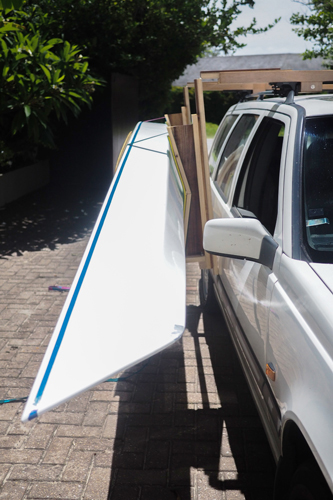
https://smallboatsmonthly.com/wp-content/uploads/2021/01/TravellingPosition500.jpg
However, even with this carrier I find the Chesapeake 16 a little heavy for me these days.
My truck rack now has pads I learned about from iceboating, where you can’t be bothered with fitted chocks in winter cold. Use 1″ pipe insulation over the whole bar and wrap it all with Gorilla tape.
I went one better, slipping a piece of 2″ ID PVC pipe over the after one with a couple of 1″ ID, 2″ OD nylon washers on each end. It too is covered with pipe insulation and tape. In my case, I made it about 16″ long and have one end against one of the vertical bar supports as it is for iceboats and kayaks. Idea is that you put one end of the boat on the roller, push it up, then move it sideways for the next one. I can solo load a 100-pound iceboat up there with the only real work being the initial lift of the boat stem. The stern is fastened to a cart that comes right along with it.
Per David Peebles comments on using a piece of pipe in a round Yakima rack, Thule actually markets a section that slides into their roof rack beams. It has a friction stop to keep it in place, so it won’t fly out rounding a turn.
Thanks, Ben. Solid, practical solutions. I’ve been hanging kayaks (now 4) in the garage/barn. Pulley into the west end, hung on lag bolts. Carabiners to attach to stern handles. Cleats here and there for tying off bow lines. I can, without step stool, hoist and loop-off to a cleat the stern lines. A step stool helps with the bow lines for further looping off to garage door elements and ceiling, joists, or beams. To avoid repeated mild TBIs, I’ve screwed in some snug-up screws to put more tension on the stern lines, elevating the bottoms. In the colder months when we’re feeding cows, the 2 or 3 ton of stored alfalfa bales make for even easier sliding on and off. The 14′ wherry is another matter. Leaning towards a pole structure just north of the barn. Am assembling one of the Ohio Trailex trailers you noted. Parts are fine but the manual needs a glass to see the tiny photo details and the parts kit does not provide a full, searchable description of all the hardware (chasing down one 1/2″ ID plastic bushing for a leaf spring).
If you don’t want to make your own chocks, I have a pair of Sherpak Quick Loops:
They work great for the trunk. The company also makes a set that you can screw into the frame under the hood, which also works well.
And just as a reminder, for canoes nothing fore and aft is as important as a good strong tie-down to the racks. The NRS tie down strap with the padded buckle is the best.
For more on the Sherpak Quick Loops, see our review in the July 2021 issue.
—Ed.
Another concern occurred to me: A friend who had partnered with another to start building kayaks (over 20 years ago) built one of their first boats for his wife. To transport it home, he simply set the kayak on roof pads and tied it down fore and aft to the ends of the car. The partner advised him to add athwartship tie downs as well. But of course he ignored this advice.
Sure enough (you can see this coming, can’t you) the brand new kayak flew off one side of the vehicle and was trashed.
And another point: I’ve followed behind cars that had canoes or kayaks held down with bungees. It’s always alarming to see the leading end of the boat lifting high above the cross bar as the bungee stretches from the strong air pressure. The driver is oblivious, as it’s happening overhead where he or she can’t see it. Even a very heavy-duty bungee will stretch like that. Bad idea, yet a lot of people think that they can get away with it.
I had a mouse problem. They chewed all of my lines and made messes out of my storage bags. I now use mouse repellent (they are little pouches with peppermint and spearmint oil). No more mice and my garage smells good.
I am reaching the point where storage is beginning to be an issue. Two kayaks (soon to be three) a Duck punt, GP14, CLC Eastport pram, and a Montgomery 17 are quickly filling my small yard. The Monty sits in the driveway, the Punt in the backyard in her cover, the larger Kayak and Pram are under the deck, and the pride of my ‘fleet’, the GP14 is in paid storage.
The thought of not lifting too much is a big one. Many years ago, when I was restoring my GP from wreck to polished little gem, I lifted her off the trailer by hand. 300 pounds of boat! Using my legs, I rested the chine on my thighs, grabbed around the gunnel, and used my legs to lift, pivot 180 degrees, and put her down on the ground. While I did not hurt myself, I did not realize the stress I had put my legs under until I sat down later and tried to get up. My legs refused!
While I thankfully came away from that with only a funny memory, I could have really hurt myself, but it does add credence to the “lift with your legs!”
If you have a pick-up, a very easy way to load a small boat is to put a slick plastic strip (usually bolted on) on the back lip of the tailgate. You can safety back the truck down most ramps and the rear-end and bearings will not get hurt by water most times as they are sealed. Many people are strong enough to then lift the front of the boat (if not too heavy) into the back of the pick-up as the plastic strip makes it easy to slide. Here in Alaska, we use the thick plastic used for dog sleds coz it is very slippery and is at least a 1/4″ thick to take recessed bolt holes. I used to do this with loaded canoe and canoe boat types. Reticent types will fret about getting grease from the rear-end/wheel bearing grease into the water. Which especially with newer vehicles is not a concern, kind of like 2-stroke outboards. Believe it or not!